It is official! I am a bird aficionado! They are beautiful and colorful, and their sweet sound reminds us of springtime. Here I want to introduce you to a tea set collection that I recently finished hand painting with pictures of my favorite garden birds on each piece of the set. The process started last summer and it took a long time since I only have access to a klin oven once a week. In porcelain painting you have to fire the paint in a klin in order to stabilize it and make it stick to the surface of the porcelain dish permanently. So let's start taking a look:
The Great tit
"The Great Tit is the largest European tit - about the size of a house sparrow.
The crown, nape and throat are black. The cheeks are white. The breast and belly are yellow with a black stripe down the centre. There is a white wing bar across the blue-grey wings. The back is a yellowish-green and the rump is blue-grey. Legs are grey-blue and the bill is black.
The sexes can be told apart by the width of the black stripe down the breast - the males have a broader stripe than the females.
Juveniles are paler and duller with yellowish cheeks and wing bar."
Here is my rendering of this wonderful bird on a porcelain cup:
 |
The great tit cup |
 |
The second side of the great tit cup |
The Siskin
www.garden-birds.co.uk:
"The Siskin is a small finch, about the size of a Blue Tit and with similar agility.
They are generally yellowish-green and yellow with a dark streaked belly and striking yellow rump, wing bars and sides of the forked tail. The legs and bill are dark brown.
The male has a black cap and bib and bright yellow cheeks. The female does not have a black crown or bib and is more heavily streaked.
Juveniles have browner upperparts and are even more heavily streaked than the female.
The Siskin, particularly the female, is often confused with the Greenfinch, but the latter is bigger and lacks the dark streaks."
 |
The siskin cup |
The second side of the siskin cup |
The Robin
I love this bird! It is so round and cute and rather cartoonish! I thoroughly enjoyed painting it on my cups.
www.garden-birds.co.uk:
"The National Bird and a common favourite, the Robin is easily recognised by most people.
The Robin is a plump bird with bright orange-red breast, face, throat and cheeks edged with grey, a white belly and olive-brown upper parts.
The sexes are very similar, if not identical, though some texts suggest that the brown forehead is "V" shaped in females, and "U" shaped in males, though even this is not always apparent. They have a brown bill and legs.
The juvenile Robin has speckled buff-brown upper parts and underparts. They have no red feathers so that adult birds do not attack them in territorial disputes. The speckled feathers are lost in a partial moult when the bird is about two to three months old.
In the winter, resident birds are joined by immigrants from continental Europe, mostly from Scandinavia; these Robins are paler than ours, have a duller red breast. The immigrants are also generally less tame because they skulk in woodlands, only British Robins are a tame garden bird.
Robins are territorial all year round; during the spring and summer this territoriality is for breeding, but at other times individual robins hold territories for feeding. Robins will defend their territories to the death, and so in the poem "Who killed Cock Robin?", another Robin rather than a sparrow would be more likely:
Who killed Cock Robin?
I said the Sparrow,
With my bow and arrow,
And I killed Cock Robin."
I said the Sparrow,
With my bow and arrow,
And I killed Cock Robin."
And these are my renderings of this cute and chubby bird on a porcelain cup:
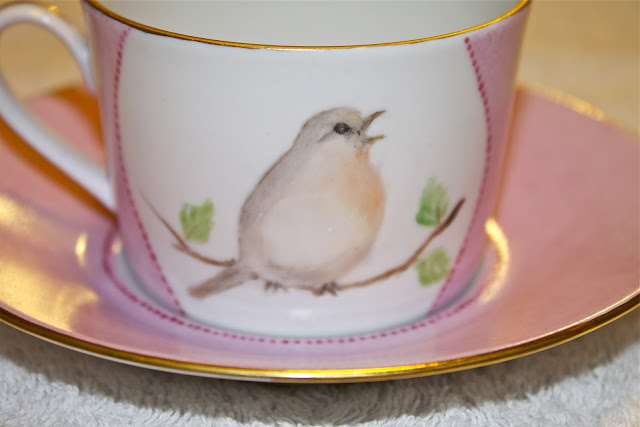 |
The robin cup |
 |
The second side of the robin cup |
The Blue Tit
This bird is very colorful and pretty! Its blueish color really makes it exceptional.
www.garden-birds.co.uk:
"At first glance the acrobatic and cheeky Blue Tit is a blue and yellow bird.
A closer inspection reveals bright blue wings, tail and crown, yellow underparts, greenish back and mantle, white cheeks, and black eye stripe, bib and collar. They also have a black streak down the middle of the belly, and a white wing bar (across the coverts). The bill is black and the legs are a blue-grey.
The sexes are similar, though the female is slightly paler.
The juvenile birds are duller than the adults and have greener crown, wings and tail, and yellow cheeks."
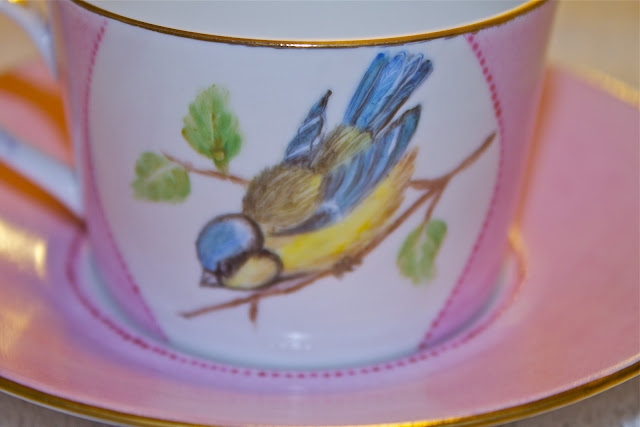 |
The blue tit cup |
 |
The second side of the blue tit cup |
The Northern Cardinal
This stunning bird is now quite well known all over the world thanks to the popular computer game "Angry Birds". The cardinal is a major character in that game. But I have always loved its sharp red color and majestic crown!
Here is a description of the Northern Cardinal according to www.allaboutbirds.org:
"The male Northern Cardinal is perhaps responsible for getting more people to open up a field guide than any other bird. They’re a perfect combination of familiarity, conspicuousness, and style: a shade of red you can’t take your eyes off. Even the brown females sport a sharp crest and warm red accents. Cardinals don’t migrate and they don’t molt into a dull plumage, so they’re still breathtaking in winter’s snowy backyards. In summer, their sweet whistles are one of the first sounds of the morning."
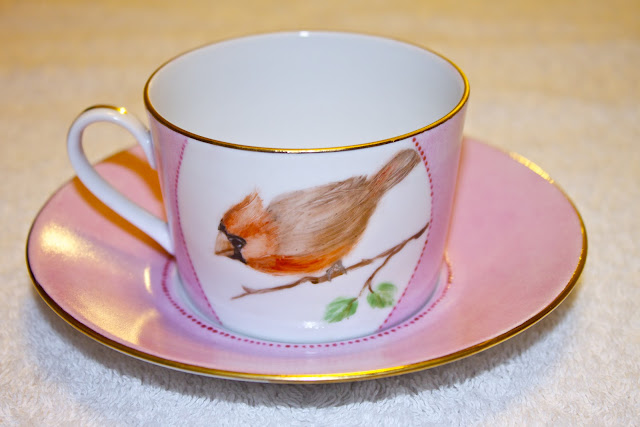 |
The cardinal cup |
 |
The second side of the cardinal cup |
The House Sparrow
I grew up in a very big city where there was very little of nature and animals and birds. But the sparrows are so resilient and adaptive that they were quite numerous and even thriving in the city environment. Some caring people also had the habit of throwing bread crumbs out the window for them to eat during the winter. My collection of garden birds could not have been complete without this most common of the garden birds.
www.garden-birds.co.uk:
"The male House Sparrow has a chestnut brown back with black streaks, while the underparts, rump and crown are grey. The nape is chestnut brown, the cheeks are dull white, and they have a black eye stripe and bib. They also have a light wing bar. The beak is a yellow-brown in winter, but black in the summer, and the legs are pale brown.
The female is paler and lacks the grey crown, white cheeks, black bib and eye stripe and chestnut brown nape, but has a straw coloured stripe behind the eye.
Juveniles are like the adult female."
 |
The sparrow cup |
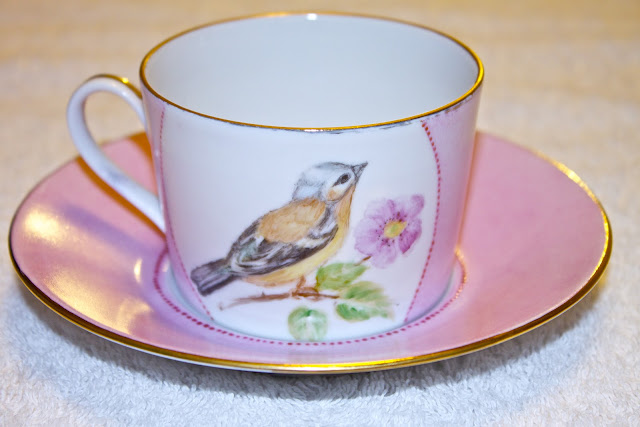 |
The second side of the sparrow cup |
These were all the six cups that belong to my hand painted china tea set. In the coming posts I will show you the other pieces of my hand painted china tea set. I hope you have enjoyed so far!
Cheers,





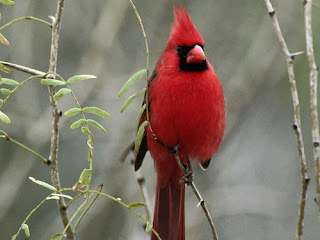


I also love birds! You paint beautiful tea cups, I wish I could make one, too.
ReplyDeleteThank you very much Rosa! You are very kind!
Delete